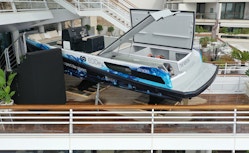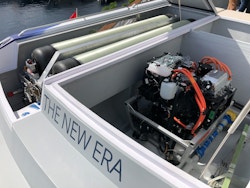EODev's REXH₂® and HYNOVA's The New Era on display in Monaco
HYNOVA Yachts and EODev unveiled on Wednesday September 23, 2020 the Range Extender H₂ (REXH₂®) solution selected by HYNOVA for the energy supply of its future HYNOVA 40, whose The New Era prototype was presented at the Yacht Club de Monaco as part of the of the Monaco Capital of Yachting Experience event. This presentation illustrated the conference on Tuesday, September 22 on hydrogen as an alternative to diesel for carbon-free maritime mobility.

Developed from the latest generation Toyota fuel cells, the REXH₂® designed by EODev is part of the industrialization of accessible hydrogen solutions for zero emissions maritime and river mobility. It allows, thanks to a hydrogen-electric hybridization combining the use of hydrogen as fuel and Alternative Energies batteries, to ensure both the propulsion of the boat and the operation of the on-board systems.
The emotion was palpable when the first electrohydrogen "dayboat" in the world was revealed on the terrace of the 3rd deck of the Yacht Club de Monaco. Strong emotions for Chloé Zaied, Managing Director of HYNOVA Yachts, but also for the EODev team, finally able to present to the public the results of the work of its engineers, after the cancellations of the Cannes and Monaco boat shows . An event all the more significant as HSH Prince Albert II also wished to support with his presence the presentation of this innovative boat, which marks a turning point in the pursuit of low-carbon maritime mobility and sustainable yachting, challenges that it faces. are particularly close to heart.

Simple principles, complex integration
This first HYNOVA 40 is the result of the involvement of many companies in the consortium set up by HYNOVA and EODev to enable its realization, without which the project would not have been possible.
From a technological point of view, around the Toyota battery, all of the electro-hydrogen hybridization carried out by EODev and its integration on board were the result of collaborative work with EVE System and Alternatives Energies.
On the naval architecture side, the optimization of the hull was carried out with the help of the company Syroco, whose supercomputers and hydrodynamic engineers have improved the efficiency of the whole by nearly 20%, thanks to the addition of foils, while the data related to the integration of completely new technological elements were unprecedented.
To put it simply, the HYNOVA is equipped with a fuel cell that transforms hydrogen into electricity. In addition to its very high energy density, hydrogen has a double interest: it is an inexhaustible resource whose combustion only releases water, oxygen and heat, which can be easily reused. As a reminder, the first internal combustion engine running on hydrogen dates from 1806, invented by the Swiss Isaac de Rivaz. The electricity produced is then either used directly to power the boat's propulsion chain via electric motors, or stored in batteries which can make it available to the propulsion and on-board systems as needed. The hydrogen (H2) gas that powers the system is stored in compressed form at 350 bar, the standard used by hundreds of buses around the world. The specially designed tanks are integrated into the boat, but on an exterior part so as to benefit from direct ventilation.
The HYNOVA 40 will thus have, in this first configuration, three tanks with a total capacity of 22.5 kg of hydrogen, placed on the rear side part of the boat, their weight being balanced by the presence of the batteries placed towards its central part. , offset longitudinally.
The solution developed by EODev to meet the specifications of the HYNOVA 40 consists of a REXH₂®, designed around the Toyota fuel cell, capable of delivering up to 80kW, and three LiFePO technology batteries of 44kW ( Lithium-Iron-Phosphate) designed by EVE Systems and approved for marine use. Finally, two BorgWarner electric motors develop a power of 184kW each (or approximately 2 x 250HP in diesel equivalent). The set has been designed to allow the boat, which weighs around 9 tonnes, to reach 26 knots at maximum speed and a working speed of 12 knots. The operating speed limit with the battery alone is 8 knots, with the boat going up to 69 miles at 6 knots.
The advantage of the hydrogen-electric combination in comparison with a 100% electric system, in addition to a significant saving in weight and therefore in energy consumption, is to make it possible to manage the needs according to the use, based on on continuous battery power in "cruise" mode, while being able to demand the batteries instantly during sporadic power calls. The assembly is managed by an automated Power Management System specifically developed by EODev, which calculates the remaining range according to the usage profile and the expected average speed, as in a car.
Chloé Zaied, Managing Director, HYNOVA Yachts, commented on the presentation of the prototype: “It is a pride to be the first company in the world to mass-produce pleasure boats equipped with this innovative technology and this unique process. I am all the more happy to share this wonderful adventure with EODev, a partner of choice! HYNOVA Yachts then hopes to be able to contribute to the development of this energy vector, which fits perfectly with my personal values. In addition to thinking and designing tenders with the least possible impact on the environment, I want to inform, promote and advance the share of green hydrogen in the world of tomorrow and register HYNOVA Yachts as a link for change towards new patterns of behavior. It is a way to participate, at my level, in the ecological transition of tomorrow. "
Make clean technologies accessible to as many people as possible
The hydrogen solutions developed by EODev have many advantages over traditional installations, diesel in particular, but also "all electric". In addition to environmental objectives, without emissions or noise pollution, the sizing of a REXH₂® assembly allows total modularity to optimize the response to energy needs, with reduced size and weight, and rapid refueling - the time of a full tank. of gasoline. The absence of moving parts in the fuel cell guarantees simplified and predictive maintenance, for a service life of at least 10,000 hours. Finally, the REXH₂® being a "plug and play" solution, it is not necessary to be an engineer specializing in hydrogen to operate the boat. As in modern cars, the system is "connected" and the data of all components is traceable and archived remotely.
